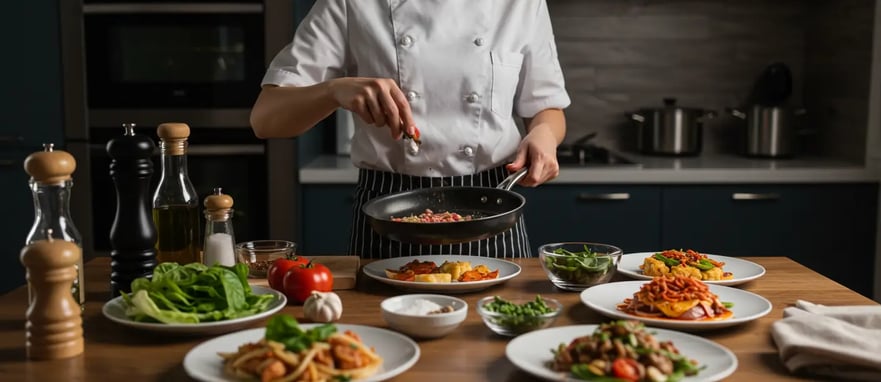
How to Cook Food Perfectly Every Time: Essential Tips & Tricks
Build on the basics by learning key tips and best practices that ensure consistent, high-quality results, regardless of the cooking method you choose.
COOKING TECHNIQUES
Mae Ellison
2/24/20254 min read


How to Cook Food Perfectly
Cooking food perfectly is an essential skill that can elevate your meals and impress your friends and family. Whether you're a beginner or an experienced cook, learning the fundamentals and mastering key techniques will help you achieve delicious, perfectly cooked dishes every time. In this guide, we’ll walk you through the most important tips, tools, and methods to ensure your cooking is flawless.
Understanding the Basics of Cooking
Cooking is both an art and a science, and mastering the basics is essential to achieving perfect results. Before diving into advanced techniques, it's important to understand the foundation of cooking.
Key Cooking Methods
There are several cooking methods, each influencing the texture and flavor of the food. Understanding how they work will help you choose the right approach:
Searing: This technique is perfect for creating a flavorful, caramelized crust on meats and vegetables. It seals in the juices, making the dish more succulent.
Roasting: Roasting vegetables or proteins at high heat brings out their natural sweetness and intensifies flavors.
Grilling: The smoky flavor from grilling can elevate any dish, especially meats and vegetables.
Mise en Place (Everything in Place)
"Mise en place" is a French cooking term that translates to “everything in place.” It describes the process of gathering and arranging all ingredients before starting to cook. This allows for smoother execution, better timing, and more controlled cooking.
Cooking Temperatures Matter
Each type of food requires different cooking temperatures to be perfect. Knowing the correct temperature is key to avoiding undercooking or overcooking. For example:
Meats: The ideal internal temperature for steak varies based on doneness (e.g., 130°F for medium-rare).
Vegetables: Roasting vegetables at around 400°F ensures they caramelize without becoming mushy.
Essential Cooking Techniques for Perfect Meals
Mastering the right cooking techniques is the next step to achieving perfect results in your kitchen. Whether you’re preparing a main course or a side dish, the method you choose will play a significant role in the outcome.
Searing for Flavor
Searing meat or vegetables on high heat creates a flavorful outer crust, thanks to the Maillard reaction (a chemical reaction between amino acids and reducing sugars). This enhances the taste and texture of the dish. Always preheat your pan and don’t overcrowd the ingredients to get the perfect sear.
Sous-vide Cooking for Precision
Sous-vide, meaning "under vacuum" in French, is a cooking technique in which food is placed in a water bath maintained at an exact, low temperature for an extended duration. This technique is ideal for cooking meats, fish, and vegetables to perfection, as it guarantees even cooking throughout, from edge to edge.
Tenderizing Meat
Getting the perfect texture when cooking meat is all about technique. To tenderize meat, you can:
Pound the meat with a mallet to soften the muscle fibers.
Marinate the meat to infuse flavor and soften it.
Cook slowly with low, indirect heat to preserve moisture and tenderness.
Avoiding Common Cooking Mistakes
Mistakes happen in the kitchen, but with a little knowledge, you can avoid the most common pitfalls that lead to underwhelming dishes.
Overcooking Food
Overcooking is one of the quickest ways to ruin a meal. For meats, use a digital thermometer to check internal temperatures and avoid cooking them past their optimal range. For vegetables, monitor their texture to ensure they retain a slight crunch and don’t turn mushy.
Not Managing Heat Levels
Heat control is crucial for cooking food perfectly. Each cooking method requires a specific heat level:
High heat for searing or stir-frying.
Medium heat for slow-sautéing or simmering sauces.
Low heat for braising or slow-cooking stews.
Forgetting to Season as You Go
Seasoning is a multi-step process. Always season in layers to build depth of flavor, rather than dumping salt and spices at the end. Taste and adjust seasoning during different stages of cooking to ensure the right balance.
Advanced Tips for Elevating Your Cooking
Once you’ve mastered the basics, it’s time to level up with advanced techniques and tips that will make your dishes even more impressive.
Food Plating and Presentation
Presentation plays a huge role in how we experience food. Artfully plated dishes enhance the dining experience, leaving a lasting impression. Use garnishes, color contrast, and arrangement techniques to elevate the aesthetics of your meal. Even something as simple as a perfectly arranged salad or a well-plated steak can make a huge difference.
Caramelization for Depth of Flavor
Caramelization is the process where sugars in food brown and develop complex flavors. Roasting vegetables, especially root vegetables like carrots or sweet potatoes, can bring out their natural sweetness and add depth to your dish.
Grilling vs. Roasting
When should you grill, and when should you roast? Grilling gives food a smoky flavor and is perfect for meats and vegetables. Roasting, on the other hand, is better for larger cuts of meat or dishes that need even heat distribution. Understanding when to use each technique is key for culinary success.
Must-Have Kitchen Tools for Perfect Cooking
The right tools can make all the difference in achieving cooking perfection. Here are some essential kitchen tools you should have in your arsenal:
Essential Cooking Utensils
A good set of chef’s knives and a cutting board are foundational tools. A sharp knife makes prep work easier and ensures uniform cooking. A digital thermometer is another must-have, especially when cooking meat to precise temperatures.
Cast Iron Pans for Even Heat
Cast iron skillets are known for their ability to hold and distribute heat evenly, making them ideal for searing meats and even baking. They retain heat longer than other pans, so you can achieve a perfect sear or crispy crust on your dishes.
Measuring Tools and Timers
Precision is key to cooking food perfectly, so make sure you have measuring spoons, cups, and a kitchen timer to stay on track. Accurate measurements help you maintain consistency, especially when baking or making complex dishes.
Conclusion: Practice Makes Perfect
Cooking food perfectly is a skill that improves with practice and patience. By understanding key techniques, mastering heat control, avoiding common mistakes, and investing in the right tools, you’ll soon be able to create restaurant-quality meals in your own kitchen. Keep in mind, the process is just as valuable as the end result. Keep practicing, learning from your mistakes, and experimenting with new techniques, and you'll be a cooking pro in no time.
